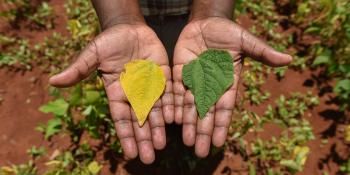Committing to climate-smart agriculture

Central America and the Dominican Republic launch a strategy that places climate-smart agriculture on the frontline in fighting climate change.
“We need to do something,” said Luis Felipe Arauz, Costa Rica’s agriculture minister in an interview with CCAFS Latin America during the International Center for Tropical Agriculture's (CIAT) 50 year celebrations in Nicaragua, on September 28. “We need an adaptation strategy for agricultural development in the region,” stressed Arauz, referring to changing Central America’s reactive behavior to climate variability as a way to prevent agricultural crises in a sustainable way.
The Central American Agricultural Council (CAC) coordinated the creation of the strategy, through its technical bodies in each SICA country, together with governmental entities, the production sector, academia, experts in gender equality and equity issues, regional and international organizations, as well as other actors from civil society.
A few minutes after, the minister went up the stage to launch the Climate-Smart Agriculture Strategy for countries in the Central American Integration Sistem (SICA) for 2018-2030 (press release), a document which draws the main lines along which agriculture in the region can become more competitive and prepared for climate changes and its short and medium-term consequences.
“We want our agriculture to be more resilient, while also bringing our global contribution – to show that cutting emissions while keeping productivity is possible,” Arauz added. Through the CSA concept, the SICA region looks to change agriculture’s old paradigms in order to ensure food and nutritional security.
Arauz, along with Eduardo Carles, head of Panama’s Ministry for Agricultural Development (MIDA), talked about the drought episode that hit Central America, the worst in the last decades. Authorities opened their eyes to the consequences of such a crisis, as well as to the ways they can become more resilient in an uncertain future. “It was a wake-up call,” said Carles in the panel that discussed the strategy, “and we need an internal integration, as setting an integrative policy in the region has always been problematic.”
 The panel led by Ana Maria Loboguerrero, regional program leader for Latin America, discussed the key aspects of the CSA strategy. Photo: A. Popescu
The panel led by Ana Maria Loboguerrero, regional program leader for Latin America, discussed the key aspects of the CSA strategy. Photo: A. Popescu
Why the need for a strategy?
As authorities in the SICA region admit, the area is highly vulnerable to regional and global climate risks:
- Increasingly exposed to extreme events, their number having tripled between 1980 and 2000s, of which 74% were floods and storms (Economic Commission for Latin American and the Caribbean - CEPAL, 2013)
- Agriculture, especially in Central America’s Dry Corridor, is vulnerable to droughts which can threaten production of staple foods
- Honduras, Nicaragua y Guatemala are in the first ten countries in the Global Climate Risk Index 2017 (Germanwatch)
- Predictions show that climate changes will intensify in the region, as changes in temperature and precipitation regimes will affect basic cereal crops.
The strategy is a key step for the region, as CSA is acknowledged for its importance in changing these socio-economic challenges and consequences. “We need to consider not only agriculture, but also access to resources, market mechanisms and consumption patterns,” said Arauz about adaptation and mitigation in the SICA region.
The word “opportunity” kept coming up during the launch, showing that mentalities are changing: difficulties become opportunities to act for local and regional well-being, as well as a reference for communities globally.
The strategy’s fundamental axes, aligned with the three pillars of CSA, according to the Food and Agriculture Organization (FAO), are:
- efficient productive systems for sustainable livelihoods
- integrated risk management and climate adaptation
- sustainable low-carbon landscapes
- enabling elements – focusing on how to support the other three axes, including finance, gender equality and equity and social inclusion.
However, CSA cannot be implemented in an isolated manner; on the contrary, it needs institutional support from policies at international, regional, national and local levels.
"How shall we do this in a coordinated, articulated manner?," asked Olga Baus Gibert, chief for the Regional Integration Section of the Delegation of the European Union to Nicaragua and to the Central American Integration System, who took part in the panel moderated by Ana Maria Loboguerrero, regional program leader for CCAFS Latin America. “What justifies a regional integration is an exchange of best practices, as well as a scientific exchange. That makes actions bring benefits.” She stressed that the elements of a strategy such as CSA has to take into account: financial predictions, clarity regarding responsibilities of each actor, donors’ opportunities and limits, efficient use of technology and real support for local women to promote gender equality.
At the same time, the contribution from producers remains critical. Michael Healy, president of Nicaragua’s Farmers' Union (UPANIC) talked about integration efforts in agriculture; he highlighted that association continues to be essential in smoothing the way information gets to producers in order to help them mitigate the impacts of climate change; through associations small producers are enabled to use their resources efficiently and sustainably.
The next step for the strategy, Arauz explained, is bringing awareness, creating the necessary alliances to implement CSA. “Climate-smart agriculture needs to be mainly knowledge-intensive, integrated throughout the entire food chain, with its principles incorporated in family agriculture.”
The inter-agency support group for CAC includes: FAO, the Inter-American Institute for Cooperation on Agriculture (IICA), CEPAL, CCAFS-CIAT, the Tropical Agricultural Research and Higher Education Center (CATIE).
Read more:
- Climate-Smart Agriculture Strategy for the SICA Region (2018-2030) - in Spanish
- Working towards a climate smart agricultural sector in Latin America
- First steps to develop climate-smart agriculture strategy for Central America and the Dominican Republic
Alexandra Popescu is the Communications Specialist at CCAFS Latin America.



